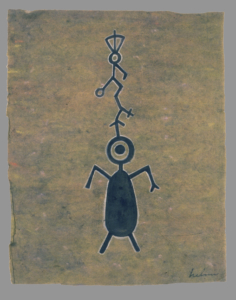Helmi’s World: Symbol, Myth, Fantasy
/in Past Exhibitions /by Christina ClaassenJune 27, 2015 - October 11, 2015
Lightcatcher Building
June 27 – October 11, 2015, Lightcatcher Building
Curated by Barbara Matilsky

Helmi Juvonen, Vantage, circa 1975-1976; Gouache on rice paper. Gift of Dr. Ulrich & Stella Fritzsche.
Helmi Juvonen (1903-1985), known in her day simply as Helmi, was a prolific artist whose creativity embraced diverse media. She was drawn to the ceremonies and arts of Northwest aboriginal culture and developed a rapport with the chiefs of the Lummi, Swinomish, Muckleshoot, Makah, and Yakama tribes. Helmi devoted years to studying and drawing Northwest Coast Indian and South Pacific objects in the Washington State Museum (later the Burke Museum).
Helmi’s World presents 65 artworks—paintings, drawings, prints and ceramics—drawn from the Whatcom Museum’s collection of her work, which numbers 250 objects. Some of her finest pieces are highlighted, including paintings of petroglyphs from Central Washington, watercolors of Lummi masked dancers, and linocut prints based on the Makah Wolf Dance experienced at Neah Bay. The exhibition suggests the complexity of Helmi’s vision by displaying some of her most unusual artworks, where images and symbols from a variety of cultures converge. The influences of Mark Tobey, Pablo Picasso, Scandinavian Folk Art, and Judeo-Christian and Buddhist iconography are also explored.
With her avid interest in anthropology, Helmi believed, as did the Seattle photographer Edward Curtis (1868-1952), in the importance of documenting Native American spiritual life. During the 1940s and 1950s, she lived with tribes in Washington, Vancouver Island, and South Dakota. Helmi also spent time studying and drawing ritual objects in the Washington State Museum, which later became the University of Washington’s Burke Museum. Helmi forged a unique style that merged aboriginal Northwest culture with modern art. The artist also conjured “imaginary things,” and many of her works reflect both the dark and light sides of the human psyche.
“Although Helmi has not yet been recognized as widely as other Pacific Northwest ‘mystics,’ such as Mark Tobey and Morris Graves, she was, in many ways, ahead of her time,” says Barbara Matilsky, the Museum’s curator of art. “Her graffiti-like abstractions, mixed-media compositions, and paper cut-outs relate to trends in contemporary art and communicate easily with a new generation of viewers.”
Born in Butte Montana in 1903, Helmi attended the Cornish School (now Cornish College of the Arts) and honed her skills as a draftsman at the Boeing Aircraft Company during World War II. Spirited and independent, she forged an unconventional path through life. Living on the edge of poverty, she later sold prints at the Pike Street Market for 50 cents apiece. The artist’s talents were well-recognized and works were purchased by important Seattle collectors. Supported in part by Dr. Richard Fuller, the founding director of the Seattle Art Museum who acquired work for the collection, the artist was friends with many Northwest art world luminaries, including Morris Graves.
During the 1950s, a period of suppression and conformity in American life, a woman living alone as an artist proved difficult. Helmi’s eccentricities, including living with dozens of cats, alarmed neighbors and family who disapproved of her creative career. For a period of time, the artist’s obsession with Mark Tobey, the most renowned of the Pacific Northwest mystic painters, embarrassed Tobey as well as his many supporters.
Helmi was mistakenly diagnosed with schizophrenia (now recognized as manic-depression), and was committed against her will to Oakhurst Convalescent Home in Elma, Washington, where she lived the final 26 years of her life. Here, she continued to make art and welcomed artists and supporters, who organized museum exhibitions that she attended, including her 1985 retrospective at the Whatcom Museum thirty years ago.
Helmi and the artist Wesley Wehr gifted many of the works in this exhibition. A large number of pieces were also donated by Dr. Ulrich and Stella Fritzsche. Dr. Fritzsche, author of the book, Helmi Dagmar Juvonen: Her Life and Work, a Chronicle (2001), has contributed greatly to our understanding of the artist’s biography.


